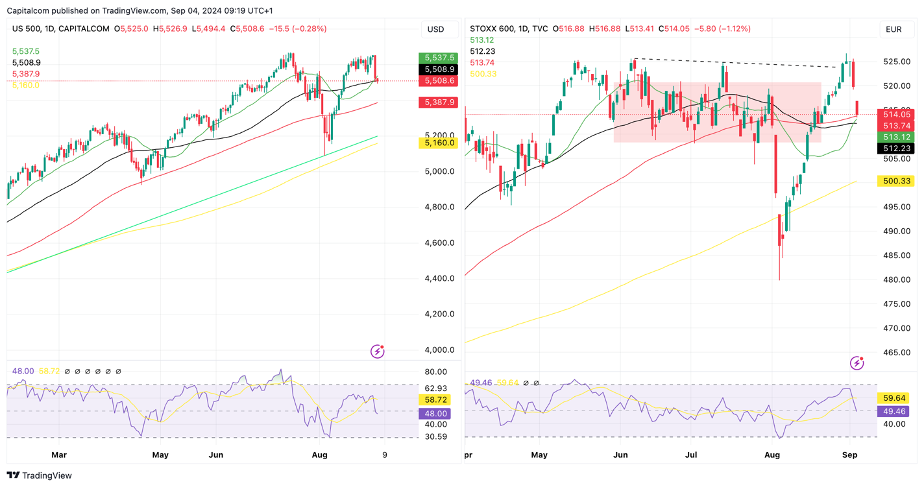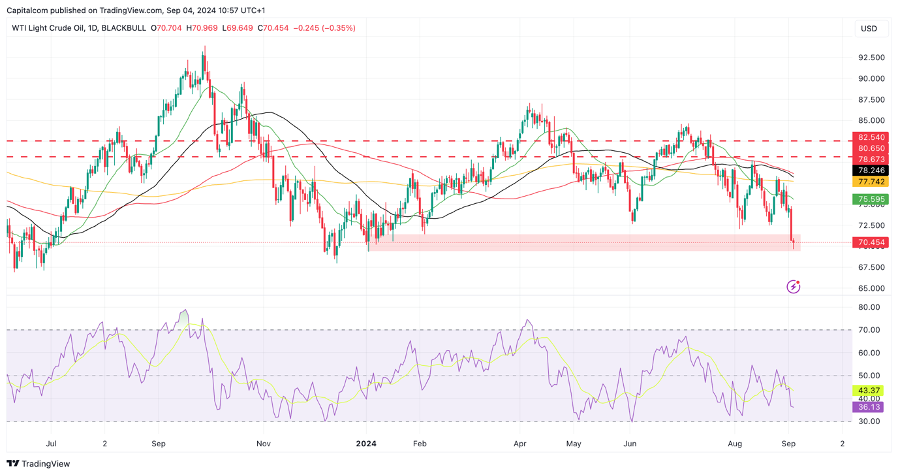US traders came back from the labour day holiday on Tuesday with a strong negative sentiment. Global equities dropped significantly in the afternoon after a relatively calm start top the European session, in what is starting to look like a repeat of August.
There doesn’t seem to be a whole lot out there to explain the intensity of the selloff, other than potentially seasonal factors. September is traditionally considered a bad month for risk appetite. Looking at how various asset classes performed, there doesn’t seem to be much else to justify the moves. With oil, gold and yields dropping alongside equites, it’s hard to justify either geopolitical concerns or safe-haven demand as the culprits of Tuesday’s selloff.
The economic calendar is also quite stale this week heading into the US jobs data on Friday which will be the key event to watch out for. Tuesday saw the ISM Manufacturing PMI data come out slightly below expectations in the US, but the reading was above the previous month, so it’s hard to see this as a key trigger of bearish sentiment.
S&P 500 & EU STOXX 600 daily charts
Past performance is not a reliable indicator of future results.
Looking at how the European session has kicked off in Asia and Europe we can expect further selling pressure on Wednesday as US traders come back online. Both the EU STOXX 600 and the S&P 500 are currently testing support at their respective moving averages, a key test of further appetite to move lower.
The seemingly lack of trigger in the pullback is likely to allow for sentiment to continue the path of least resistance heading, which currently seems to be lower. Thursday will see the ISM non-manufacturing PMIs as well as the ADP employment data, and whilst it is often not the best predictor of what the official jobs data will report on Friday, we could see some momentum stemming from the release.
Meanwhile, oil prices saw their worst performance since October last year, with US crude erasing the 2024 gains, dropping to a 9-month low. Ongoing geopolitical concerns haven’t been able to stop the negative sentiment that took over risk-appetite on Tuesday. Concerns about global oil demand seem to have aided the selloff. It is also likely that expectations for OPEC+ production cuts to end over the coming months continue to weigh on sentiment as a global economic slowdown takes place. Meanwhile, Iraq, the largest overproducer within OPEC+, continues to increase its output, .
US crude (WTI) daily chart
Past performance is not a reliable indicator of future results.
US crude (WTI) has entered a key support range between $69.40 and $71.40 which has already helped to minimise some of the pullback on Wednesday. Current price has pulled away from the daily lows and is hovering just above the $70 mark but the technical point towards further downside pressure if the bearish appetite cannot be contained above $69.50.
Disclaimer: This is for information and learning purposes only. The information provided does not constitute investment advice nor take into account the individual financial circumstances or objectives of any investor. Any information that may be provided relating to past performance is not a reliable indicator of future results or performance. Social media channels are not relevant for UK residents.
Spread bets and CFDs are complex instruments and come with a high risk of losing money rapidly due to leverage. 84.01% of retail investor accounts lose money when trading spread bets and CFDs with this provider. You should consider whether you understand how spread bets and CFDs work and whether you can afford to take the high risk of losing your money.
The information provided is not to be considered investment advice or investment research. Capital.com will not be liable for any losses from the use of the information provided.'
- English (USA)
- English (India)
- English (Canada)
- English (Australia)
- English (South Africa)
- English (Philippines)
- English (Nigeria)
- Deutsch
- Español (España)
- Español (México)
- Français
- Italiano
- Nederlands
- Português (Portugal)
- Polski
- Português (Brasil)
- Русский
- Türkçe
- العربية
- Ελληνικά
- Svenska
- Suomi
- עברית
- 日本語
- 한국어
- 简体中文
- 繁體中文
- Bahasa Indonesia
- Bahasa Melayu
- ไทย
- Tiếng Việt
- हिंदी
Global equities suffer another strong pullback, but oil lead the way this time
Published 04/09/2024, 11:03
Global equities suffer another strong pullback, but oil lead the way this time
Latest comments
Loading next article…
Install Our App
Risk Disclosure: Trading in financial instruments and/or cryptocurrencies involves high risks including the risk of losing some, or all, of your investment amount, and may not be suitable for all investors. Prices of cryptocurrencies are extremely volatile and may be affected by external factors such as financial, regulatory or political events. Trading on margin increases the financial risks.
Before deciding to trade in financial instrument or cryptocurrencies you should be fully informed of the risks and costs associated with trading the financial markets, carefully consider your investment objectives, level of experience, and risk appetite, and seek professional advice where needed.
Fusion Media would like to remind you that the data contained in this website is not necessarily real-time nor accurate. The data and prices on the website are not necessarily provided by any market or exchange, but may be provided by market makers, and so prices may not be accurate and may differ from the actual price at any given market, meaning prices are indicative and not appropriate for trading purposes. Fusion Media and any provider of the data contained in this website will not accept liability for any loss or damage as a result of your trading, or your reliance on the information contained within this website.
It is prohibited to use, store, reproduce, display, modify, transmit or distribute the data contained in this website without the explicit prior written permission of Fusion Media and/or the data provider. All intellectual property rights are reserved by the providers and/or the exchange providing the data contained in this website.
Fusion Media may be compensated by the advertisers that appear on the website, based on your interaction with the advertisements or advertisers.
Before deciding to trade in financial instrument or cryptocurrencies you should be fully informed of the risks and costs associated with trading the financial markets, carefully consider your investment objectives, level of experience, and risk appetite, and seek professional advice where needed.
Fusion Media would like to remind you that the data contained in this website is not necessarily real-time nor accurate. The data and prices on the website are not necessarily provided by any market or exchange, but may be provided by market makers, and so prices may not be accurate and may differ from the actual price at any given market, meaning prices are indicative and not appropriate for trading purposes. Fusion Media and any provider of the data contained in this website will not accept liability for any loss or damage as a result of your trading, or your reliance on the information contained within this website.
It is prohibited to use, store, reproduce, display, modify, transmit or distribute the data contained in this website without the explicit prior written permission of Fusion Media and/or the data provider. All intellectual property rights are reserved by the providers and/or the exchange providing the data contained in this website.
Fusion Media may be compensated by the advertisers that appear on the website, based on your interaction with the advertisements or advertisers.
© 2007-2025 - Fusion Media Limited. All Rights Reserved.
